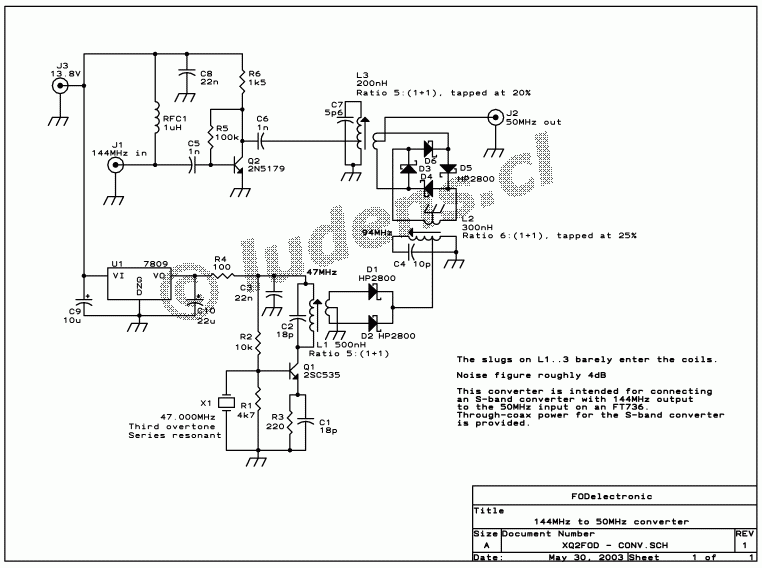 Here
is the schematic of my converter. You can click on the image to get a 300dpi
version for high quality printing.
Here
is the schematic of my converter. You can click on the image to get a 300dpi
version for high quality printing.
But I couldn't find any ready-made 2400MHz to 50MHz converter. I didn't want to build it, because importing the necessary microwave material in small quantities would have been far more expensive than buying a ready-made unit. So I finally ordered a 2400MHz to 144MHz converter from DB6NT, which appealed to me because of its excellent specifications and small size. It has a noise figure that's low enough to render an added preamplifier pointless, which in part compensates for its rather high cost. The converter was mounted in a hermetic box on the antenna. The box contains a big bag of silica gel to keep the inside dry.
At first I fed the 144MHz signal into the 2m portion of the radio. It worked well enough, but the input noise figure of the FT736 is such that it did have a noticeable effect on overall noise figure. More gain was necessary in front of the radio, despite the fact that the DB6NT converter already has a healthy amount of gain! So I put my original plan into practice, and built a 144MHz to 50MHz converter with a noise figure lower than the FT736. Using it, I have now all four satellite bands available under computer control, and the noise figure is set by the converter to well below 1dB.
 Here
is the schematic of my converter. You can click on the image to get a 300dpi
version for high quality printing.
Here
is the schematic of my converter. You can click on the image to get a 300dpi
version for high quality printing.
The converter is a very simple design. A third overtone crystal oscillator runs on 47MHz. Its output is doubled in a highly efficient Schottky diode doubler, so that it can drive a Schottky diode ring mixer without needing any further amplification. The 144MHz input signal is passed through a very simple amplifier which uses a low noise bipolar transistor biased for 50 Ohm input impedance. This amplifier provides a gain of roughly 10dB, which is enough to overcome the mixer loss and leave a few dB over for additional gain. The FT736 ends up with the signal meter just trying to get off the resting position with the thermal noise received when pointing the antenna at the horizon. I feel this is about the optimal gain for best compromise between sensitivity and overload resistance.
The converter uses no filters and is thus pretty broadbanded. All selectivity is trusted to the DB6NT converter and the Yaesu radio. The power supply is regulated by a three terminal voltage regulator, so the frequency won't shift with input voltage fluctuations. The converter applies 13.8V to the coax line going to the antenna-mounted converter, so that one doesn't need a separate power cable.
Adjustment of this circuit consists simply in tuning the three coils to maximum signal, then retouching L1 to obtain the precise frequency.
I built this converter in dead bug style on a small piece of copper clad board. It doesn't look nice, so I won't show you a photo, but it works very well!